You searched for: 德國博彩推广渠道【TG飞机:@bapingseo】脸书广告投放【TG电报:@bapingseo】伊拉克google开户【Telegram:@bapingseo】ag真人娱乐首页奥门新美高梅线上娱乐场?5CaSOz/323201.html
<< Previous | Displaying results 151-175 of 556 for "德國博彩推广渠道【TG飞机:@bapingseo】脸书广告投放【TG电报:@bapingseo】伊拉克google开户【Telegram:@bapingseo】ag真人娱乐首页奥门新美高梅线上娱乐场?5CaSOz/323201.html" | Next >>
-
Denmark
ArticleLearn about the Jewish population of Denmark, the German occupation, and resistance and rescue in Denmark during WWII and the Holocaust.

-
Fischel (Philip) Goldstein
ID CardFischel was the youngest of five children. He came from a Jewish family of artisans; his father was a tailor, his uncles were furriers, and his sister was a dressmaker. Fischel started his education at a Jewish parochial school at age 3, where he studied Hebrew and Yiddish. He continued his education at Jewish private schools until age 10, when he entered Polish public schools. 1933-39: After graduating from the Polish public school system at age 14, Fischel started an apprenticeship in his father's…

-
Jewish Badge: During the Nazi Era
ArticleNazi officials implemented the Jewish badge as a key element in their plan to persecute and eventually destroy the Jewish population of Europe. Learn more
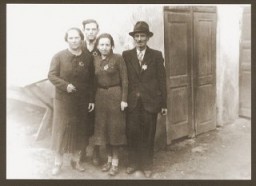
-
Wool Bedcover
ArtifactFollowing the Soviet occupation of Lithuania, the Lifszyc family began to search for ways to leave the country. David Lifszyc obtained a Curacao visa from the Dutch consulate. He also obtained an American visa because he was included on a list of distinguished rabbis submitted to the State Department by the Agudat Israel of America. After obtaining Soviet exit visas, the Lifszycs purchased tickets for Vladivostok on February 5, 1941. They started for Moscow, where they received Japanese transit visas. This…
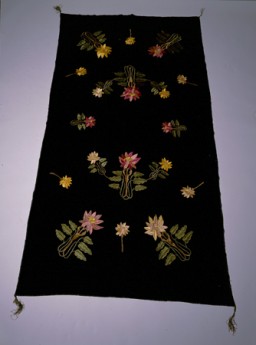
-
Beifeld album page illustrating fortifications and first fatality
Artifact(Bottom) View of fortifications built at Kalimovka to defend the advancing troops of the 4th Infantry Division of the Hungarian 2nd Army. In the lower right corner of the drawing, men prepare the grave of Jewish Labor Serviceman Nandor Klein, the first fatality of the company. The Hungarian caption reads: The death of our first hero, Nandor Klein, his grave, June 5, 1942." Klein was killed by a stray Soviet bullet on his way back to base. [Photograph #58013]

-
Adolf Hitler greets Paul von Hindenburg
PhotoRecently appointed as German chancellor, Adolf Hitler greets President Paul von Hindenburg in Potsdam, Germany, on March 21, 1933. This pose was designed to project an image of Hitler as non-threatening to the established order. This particular image is from a popular postcard. The photo also appeared widely in both the German and international press. Hitler appears in civilian dress, bowing in deference to the heavily decorated von Hindenburg. The March 5, 1933, elections had conferred legitimacy on…
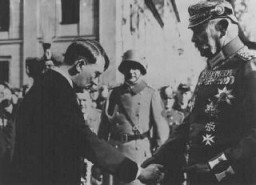
-
Auschwitz I camp, 1944
MapSelected Features 1. Camp Commandant's House 2. Main Guard House 3. Camp Administrative Office 4. Gestapo 5. Reception Building/Prisoner Registration 6. Kitchen 7. Gas Chamber and Crematorium 8. Storage Buildings and Workshops 9. Storage of Confiscated Belongings 10. Gravel Pit: Execution Site 11. Camp Orchestra Site 12. "Black Wall" Execution Site 13. Block 11: Punishment Bunker 14. Block 10: Medical Experiments 15. Gallows 16. Block Commander's Barracks 17. SS Hospital

-
Two young brothers in the Kovno ghetto
PhotoTwo young brothers, seated for a family photograph in the Kovno ghetto. One month later, they were deported to the Majdanek camp. Kovno, Lithuania, February 1944. Pictured are Avram (5 years) and Emanuel Rosenthal (2 years). Emanuel was born in the Kovno ghetto. The children, who were deported in the March 1944 "Children's Action," did not survive. Their uncle, Shraga Wainer, who had asked George Kadish to take this photograph, received a copy of it from the photographer after the war in the Landsberg…
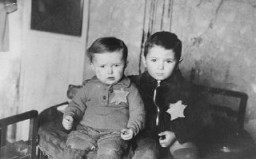
-
Hainichen
ArticleIn 1933, the Nazis established the Hainichen labor camp in Sachsen, Germany. Learn more about the camp, its closing, and the prisoners.
-
Subsequent Nuremberg Proceedings, Case #3: The Justice Case
ArticleThe Justice Case was Case #3 of 12 Subsequent Nuremberg Proceedings against leading German industrialists, military figures, SS perpetrators, and others.
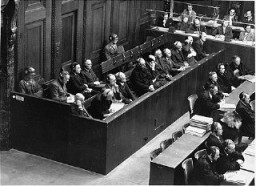
-
Subsequent Nuremberg Proceedings
ArticleAmerican military tribunals presided over 12 Subsequent Nuremberg Proceedings against leading German industrialists, military figures, SS perpetrators, and others.
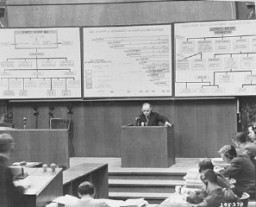
-
Subsequent Nuremberg Proceedings, Case #12: The High Command Case
ArticleThe High Command Case was Case #12 of 12 Subsequent Nuremberg Proceedings against leading German industrialists, military figures, SS perpetrators, and others.
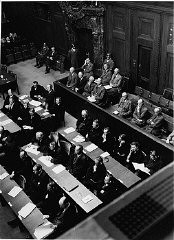
-
Bernard Druskin
ArticleRead the Jewish Partisan Educational Foundation's short biography of Bernard Druskin.
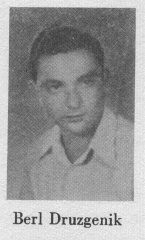
-

-
Police maintain watch outside the Eldorado nightclub, long frequented by Berlin's gay and lesbian community.
PhotoPolicemen stand outside the shuttered Eldorado nightclub, long frequented by Berlin's gay and lesbian community. The Nazi government quickly closed the establishment down and pasted pro-Nazi election posters on the building. Berlin, Germany, March 5, 1933. Learn more about this photograph.

-
The 26th Infantry Division during World War II
ArticleThe 26th Infantry Division participated in major WWII campaigns and is recognized for liberating the Gusen subcamp of Mauthausen in 1945.
-
Eva Heyman: Maps
Media EssayEva was born to Jewish parents and grew up in a city on the border between Romania and Hungary. On March 19, 1944, the Germans occupied Hungary and Eva was soon forced into a ghetto. She was later deported to Auschwitz, where she was killed at the a...
-
Jozef Wilk: Maps
Media EssayBorn to Roman Catholic parents in Poland, Jozef Wilk was a teenager when Germany invaded in 1939. Jozef left for Warsaw and joined a special unit of the Polish resistance. During the 1943 Warsaw ghetto uprising, Joz...
-
Hannah Szenes
PhotoHannah Szenes on her first day in Palestine. Haifa, Palestine, September 19, 1939. Between 1943 and 1945, a group of Jewish men and women from Palestine who had volunteered to join the British army parachuted into German-occupied Europe. Their mission was to organize resistance to the Germans and aid in the rescue of Allied personnel. Hannah Szenes was among these volunteers. Szenes was captured in German-occupied Hungary and executed in Budapest on November 7, 1944, at the age of 23.
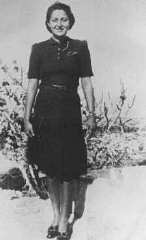
-
Antisemitism illustration from a Nazi film strip
PhotoAn antisemitic illustration from a Nazi film strip. The caption, translated from German, states: "As an alien race Jews had no civil rights in the middle ages. They had to reside in a restricted section of town, in a ghetto." Place and date uncertain.
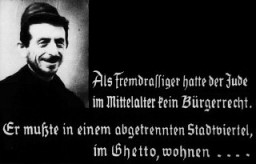
-
Norman Salsitz's daughter
PhotoNorman's daughter, Esther, at age one. April 1957. With the end of World War II and collapse of the Nazi regime, survivors of the Holocaust faced the daunting task of rebuilding their lives. With little in the way of financial resources and few, if any, surviving family members, most eventually emigrated from Europe to start their lives again. Between 1945 and 1952, more than 80,000 Holocaust survivors immigrated to the United States. Norman was one of them.
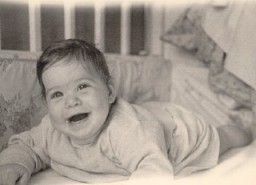
-
Reversal of Fortune: Robert Kempner
ArticleLawyer Robert Kempner was expelled from Germany in 1935. After WWII, he would return to serve as assistant US chief counsel during the IMT at Nuremberg.
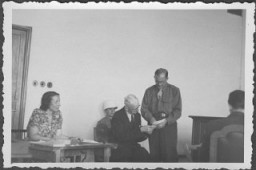
-
James Ingo Freed: Architect of the Museum
ArticleArchitect James Ingo Freed designed the United States Holocaust Memorial Museum.
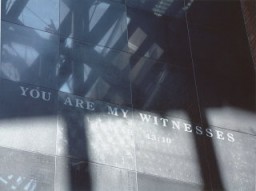
-
Rut Berlinska
ArticleChildren's diaries bear witness to some of the most heartbreaking experiences of the Holocaust. Learn about the diary and experiences of Rut Berlinska.
-
Miriam Goldberg
ArticleChildren's diaries bear witness to some of the most heartbreaking experiences of the Holocaust. Learn about the diary and experiences of Miriam Goldberg.
